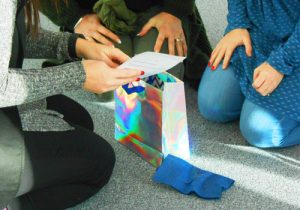Sensory stories for sensory difficulties by Joanna Grace
27th June 2017
Share this entry:

As we experience our world our senses and our brain work together to make sense of what we encounter. In our early life we use our experiences to set a sort of sensory volume control in our head. So, for example, a child whose early life has been very peaceful and plain may find a classroom environment busy and overwhelming, whereas to a child whose early life has been loud and chaotic the classroom may appear dull. Our sensory experiences are subjective; one person’s experience of their environment is just that: one person’s experience. How you feel about the place you work does not inform you of how the children you support feel about that place.
Children experiencing sensory issues may not have had the exposure they need to sensory experience to enable them to set their internal sensory volume control. Practice can help. But when your sensory volume is on the wonk (not a technical term, please forgive me!) sensory experiences can be a bit frightening. Imagine how you would feel if I offered you an object to touch and you did not know whether it was going to be sharp or hot or cold or sticky. Someone experiencing difficulties with their senses may not be able to rely on past experience to inform them of what future experience will be like. Repetition is vital. Repetition also helps people to feel safe and secure, they know what to expect and through repetition, they grow more confident in their capabilities to explore a stimulus.
Stories are naturally fun so providing repeated sensory experience through a story is ideal. Stories are just one way to provide repeated sensory experience, other ways will be just as effective but stories can be particularly good as their natural structuring helps everyone to remember what is going to happen.
To support a child who is struggling with their senses in some way, for example a child who finds the tipping out of bricks onto the carpet too noisy, I would create a sensory story full of experiences they love: the taste of something sweet, the sound of a favourite song, and so on, and include in that story a challenging experience, in this example the noise of the bricks.
I would then tell this story everyday, perhaps with the whole group, perhaps just with this child. I would begin with a muffled version of the bricks, padding the box with fabric to deaden the sound and pouring just a few bricks onto a cushion. Through the repetitions I’d increase the strength of the stimulus, watching to make sure I wasn’t pushing that child beyond what they were able to cope with.
During group sharings, I might help other children to understand that this child found the brick noise difficult. With understanding children are naturally very caring, understanding can lead to peers being more thoughtful as they play.
During individual sharings I might talk more to the child about how they could cope with the experience if it happened outside of the story, e.g. covering ears, or how they might respond to the experience, e.g. withdrawing rather than punching, and praise them for how well they have handled it within the story.
By offering a child who struggles with a particular sensory experience the opportunity to experience it repeatedly in a safe environment you are supporting them in tuning their sensory volume control to match the world they occupy. A sensory story is a super way of offering a rich variety of sensory experience in an engaging way, and what’s more they’re a lot of fun to share for everyone.
If you would like to find out more about sensory stories a free basic guide to sharing the stories can be downloaded from http://jo.element42.org/sensory-stories where you can also find the stories old by The Sensory Projects and a variety of free summary leaflets which can be useful if you want to introduce the idea to other people. You may also be interested to read my book Sensory Stories for children and teens which is available on Amazon.
If you would like to attend or book a training day focused on sensory stories and how to get the most out of them for the people you support please visit http://jo.element42.org/training
Click here to register for your free tickets to attend Childcare Expo Midlands on 29th & 30th September 2017.
Why attend Childcare Expo?
Join over 2,500 like-minded individuals from the early years sector who are dedicated to improving both practice and their childcare settings.
Attend educational seminars to credit your CPD
Meet the experts to have your questions answered
Receive fantastic onsite offers and discounts
Experience expert-led informative hands-on workshops
Network with peers and industry players
Pick up hundreds of new product ideas and services
And most of all, enjoy a great day out with your colleagues




